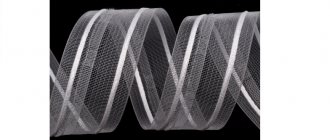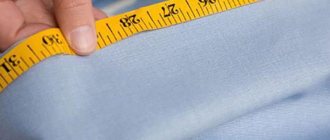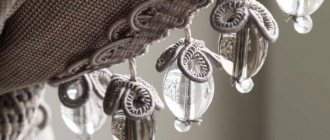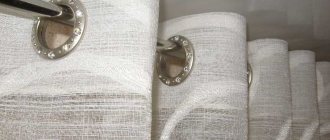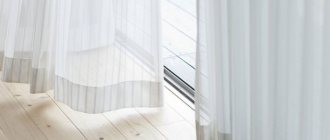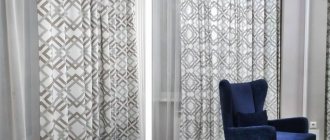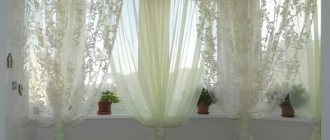Types of curtain tapes: overview
Types of curtain tapes
Curtain tape is a fabric strip that is sewn to the back of the product. The ribbon contains cords that allow you to adjust the width of the material.
Braid can create a chic drapery on any fabric. It is also convenient that you do not need to sew additional loops for hooks. This reduces the time of sewing tulle and helps to quickly pull it together with thread on the sides. The braid allows you to adjust and fix the width of the curtain.
Designers use several types of curtain tapes. Here's their review:
- Narrow ribbon - up to 4 cm .
- Wide - up to 15 cm.
- With tucks.
- Forming bows.
- With a small number of draw-out pockets for hooks and an increased number of them.
- Different in assembly coefficient - from 1.5 to 3 . This determines how often the folds will be placed on the product.
- Sew-on - attached to the product using a seam. cars.
- Adhesive to the product with a hot iron.
- Fixed to the cornice using adhesive tape with loops.
Also, the curtain tape can come complete with the following items:
- Eyelet rings
- Special seals
- Pockets for fastening with hooks
- Cords for tie.
When selecting braid, you need to take into account its length, which depends on the size of the folds that you want to create on the product.
Attaching curtains to curtain rods with guide profiles + photo
In these frames, fasteners are attached to the frame profiles for hanging the curtain. In most cases these are hooks and pendants.
To attach curtains to hooks, you can
- Sew loops or eyelets from the rope to the top of the curtain. The diameter of the rings and rings should be slightly larger than the thickness of the hanging hook so that the curtains are more securely attached to the hangers.
- Sew mounting tape that includes installation loops, and attach curtain rod hooks to these loops.
Tulle gathering coefficient for curtain tape: what does it mean?
This term denotes a ratio equal to the fabric to that already collected using a ribbon. It depends on the complexity of the pattern and there are such assembly coefficients:
- 1,5
- 2
- 2,5
- 3
For example, if you buy a strip with a coefficient of 2 , then from tulle 4 m wide, you will get exactly 4 meters of a beautifully draped transparent curtain. This indicator can be found on the packaging for the accessories.
Worth knowing: The assembly factor is also taken into account when purchasing the ribbon itself. After all, it is attached to a flat fabric and pulled together only before it needs to be hung.
To find out the required length, multiply the width of the cornice by the gathering factor +6 cm at the edges.
Tulle mesh: how to sew curtain tape?
The curtain tape is sewn to the tulle mesh.
For the tulle mesh, it is recommended to use a translucent nylon ribbon. In this case, the ribbon will be less noticeable. Choose the color of the fabric. The width of the strip is no more than 6 centimeters . How to sew curtain tape to mesh tulle? First prepare the tulle and ribbon:
- Leave an extra 3-4 cm on each side of the braid.
- Also leave extra centimeters ( 3-4 cm ) near the fabric.
- During work, do not allow strong tension on the fabric and threads.
Step-by-step instruction:
- Iron all the tulle. Fold 1 centimeter of fabric over the top and iron.
- A curtain ribbon is applied to the folded fabric. 5 millimeters from the edge .
- Use a thread to secure the ribbon to the fabric.
- Sew evenly on the machine. There are as many lines as there are cords in the tape.
- Trim the ribbon so that each edge is one and a half centimeters shorter than the fabric.
- Make two folds on the fabric. First, fold it completely, then part of the tape.
- Sew the edges of the fabric. The main thing is that the cords are not sewn into the collar.
- Pull the tulle to the required width.
To secure the tulle, it is most convenient to use special clothespins.
How to sew a wide curtain tape to tulle and make folds: instructions, photo
Curtain tape with which you can make folds
To change a boring interior a little, you don’t have to rush to the store for building materials and wallpaper. It will be enough to change the curtains on the windows. This step will not only save money and time, but will also add newness to the room. For example, buy new tulle and sew it to a wide curtain tape. Here are instructions on how to sew such a braid to tulle and make folds:
First you need to choose the right tape:
- For tulle, you need to take transparent braid, so it will not show through and will not spoil the look of the curtain.
The next step is to correctly calculate the required length of the tape:
- The length of the ribbon should be proportional to the length of the tulle.
- Calculation of the length of the tulle and, accordingly, the tape is made based on the size of the window opening plus 10-15 centimeters .
- For example, the length of a window is 1 meter , then it is recommended to take tulle in a ratio of 1/2 or 1/3 . Where 1 is the length of the window, and 2 or 3 is the length of the tulle, respectively.
- That is, for 1 meter of window length you need to take 2 or 3 meters of tulle.
Curtain tape sewn to tulle
Next, let's look at the process of sewing tape to tulle:
- The first step is to sew the sides and bottom of the tulle.
- We turn the top edge 3 centimeters (no more) and iron the bend.
- Applying the ribbon to the wrong side, step back 1 centimeter from the top edge and secure the ribbon to the tulle. You can baste or use pins and needles.
- Once the ribbon is secured, stitch along the top and bottom edges. If the folds are supposed to be complex, you need to stitch the tape near each cord.
After the ribbon is sewn, you need to make folds by tightening the cords. When the folds are ready, hang the tulle on the curtain rod.
Types of folds
When choosing a curtain tape, pay attention to the type of folds it forms. The following types are popular:
- Pencil is a common type of gather in the form of repeating narrow, rounded folds. Tulle on tape is assembled mainly in this way.
- Columns are evenly spaced narrow folds.
- Buffs (wafer) are uneven folds that imitate a waffle surface.
- Butterfly - clear diamond-shaped figures formed by four laces.
- Bow folds are paired folds, the creases of which are directed in different directions.
- Counter folds - the folds are directed towards each other.
- Glasses - spectacular volumetric folds (can be filled), similar to a glass on a stem.
- Fan. When pulled together, beautiful folds are formed on the fabric, extending from a common point in the form of a fan.
The choice of drapery when designing curtains is influenced by the style of the room. In laconic interiors, simple solutions are appropriate: pencil, bow or counter folds. Pretentious styles correspond to original draperies: fan, glass, etc.
How to sew a narrow curtain tape to tulle: instructions, photo
Narrow curtain tape sewn to tulle
If you decide to change the design by replacing curtains and tulle, you need to know some rules. First, you need to decide what folds you want to see on your future curtain. If you like complex folds, then you need to take a wide curtain braid. Well, if it is light transparent tulle, then it is better to take a narrow curtain tape. Here are instructions on how to sew a narrow curtain tape to tulle:
- Calculate the required amount of tulle and the ribbon itself. Remember: the length of the curtain tape is equal to the length of the tulle +25 cm .
- The calculation is made strictly depending on the length of the window opening. If you like a lot of folds, then you need to take tulle at a ratio of 1 to 3 . That is, for 1 meter of window length, 3 meters of tulle.
- If you want to make a design with a small number of folds, then the coefficient will be correspondingly smaller.
- Now overcast and stitch all sides of the tulle except the top. 1-2 centimeters is made on the upper side .
- After the fold is made, iron the curtain thoroughly.
- 0.5 centimeters from the top edge , apply the curtain tape and baste it by hand.
- Now stitch the tape along the top and bottom edges.
Tie the edges of the cords on the curtain tape
- Once the ribbon is sewn, make folds. To do this, pull a special cord and tie the edge into a knot.
After this, we even out the folds along the entire length of the tulle and hang the curtain on the cornice.
How to hem curtains: master class
Even if you buy ready-made curtains or sew them to order, hemming curtains at home with your own hands has its advantages. When you're hemming your own curtains, you can get the exact length you want by hanging the curtains on a curtain rod and exploring different options. Perhaps what satisfied you at the idea/sketch stage, you will want to adjust on the finished curtains, making them a little longer or shorter. Therefore, when ordering, making with your own hands or buying curtains, it is optimal to choose a length slightly larger than needed according to measurements, and then hem the curtains yourself.
You will need:
- curtains;
- centimeter and ruler (ideally a tape measure);
- chalk;
- sewing machine and threads to match the color of the curtains;
- overlock (if available);
- iron;
- pins.
How to sew curtain tape to tulle diagonally: show in the instructions
Curtain tape sewn diagonally to the tulle.
Today's design delights are full of unexpected and unusual solutions. Curtains or tulle hanging diagonally are no exception. If you have a design idea in which the tulle will hang on a baguette in an unusual way, then you need to approach this idea accordingly.
Having decided on the size and number of folds, you need to choose a curtain tape. For light tulle, a thin transparent braid is perfect. It’s easy to calculate the required amount of curtain tape:
- In the usual case, the length of the ribbon is equal to the length of the tulle.
- In our version, the number of meters of tape will be equal to the length of the tulle folded diagonally.
Curtain tape sewn to the tulle diagonally
. All other steps are the same as when the tape is sewn along the top edge. We show in detail in the instructions how to sew curtain tape to tulle diagonally:
- First, bends are made on all sides.
- Each fold is ironed and stitched using a sewing machine.
- When all four sides are ready, the tulle is folded diagonally, in the shape in which it will hang on the curtain rod.
- The tulle must be ironed at the fold location.
- Secure the fold with pins or make a mark along the entire length.
- Then apply the tape, stepping back a few millimeters from the edge.
- Secure the curtain tape to the tulle with pins.
- Sew the tape along the entire length of the tulle, from the top and bottom edges. Make sure that the stitching does not cross the ribbon cord.
- While sewing, keep the ribbon, like tulle, taut.
When the ribbon is already sewn, tighten it with cords, thereby forming folds. Next, hang the tulle on the cornice.
Curtain braid, varieties, description
Decorative braid is sewn on the front or back side of the product. It not only serves as a fold assembly, but also decorates the product. Original decorative braid for curtains can be sewn: on the bottom edge, along the perimeter, on the sides. It can be additionally decorated with stones, rhinestones, lurex, and beads.
Its use for window decoration has recently become very common among designers, needlewomen and curtain sewers.
Types of decorative braid:
- For buffs. This type creates a decorative drapery of a special shape. This technique looks great on plain materials, creating a corrugated effect.
- Ruffles. They are sewn onto the front side of the product. A country style curtain is the most common model using decorative fittings in the form of ruffles.
- With ornament. These are products with a variety of patterns and ethnic motifs. You can find decorative braid in Greek, Moroccan, African, English, Arabic, and Japanese styles. With the help of such a decorative detail, accents are placed and a special ethnic element in the interior is emphasized.
- With Fringe. Used in styles with lush decoration: art deco, classic, empire, Victorian, oriental style.
- Openwork with lurex. An original finish for curtains that will make the product elegant and complete.
This inconspicuous detail can turn even the most boring curtains into chic drapes.
Braid with loops
Tapes for curtains with loops are widely used; they are inexpensive and can be sewn to the back surface of curtains without much difficulty. Along the top and middle line of the product there are rows of loops for hooks. There may be several of them.
The most convenient thing about it is that it is made not of stretchy fabric, but of dense material.
- With two rows of loops. For normal hanging of curtains on hooks.
- With four rows of loops. For adjusting the length of curtains without shortening the edges.
Note! If the curtains sag, it means there are not enough curtain hooks and they are not designed correctly. The second reason: the braid is too thin and narrow.
It is easy to sew on a machine to the fabric, and the folds can be made of any density.
Braid with loops can be of two types:
- Transparent. Made from nylon, designed for light translucent fabrics: organza, veil, mesh. Such fittings will be invisible on thin and light fabric. The process of sewing transparent tape is more labor intensive and requires some experience and skill.
- Not transparent tape. Made from cotton for thick curtain fabrics. Before work, it is necessary to steam the tape to avoid unwanted shrinkage on the finished product.
Their size and quantity can be adjusted with several laces passed through the entire length of the tape.
Adhesive tape for curtains
The use of adhesive fittings for curtains is justified only if the material is light.
Curtain tape simplifies the process of sewing curtains.
The procedure for fixing the adhesive tape.
- Heat the strip with an iron; the high temperature will melt the glue on the tape to a liquid state.
- Carefully fix the tape on the curtain before the glue hardens: it is securely connected to the curtain.
It does not require sewing loops to secure the fabric to the hooks - these loops are already provided on the tape.
Curtain tapes
They are divided into two types according to the formation of types of assemblies.
- Horizontal assemblies. Used for sewing traditional curtains and lambrequins.
- Vertical assemblies. Used for sewing Roman, French and Austrian curtains with lifting mechanisms.
Curtain tape allows you to beautifully drape fabric of any density and texture.
